What Russia will fly to the moon
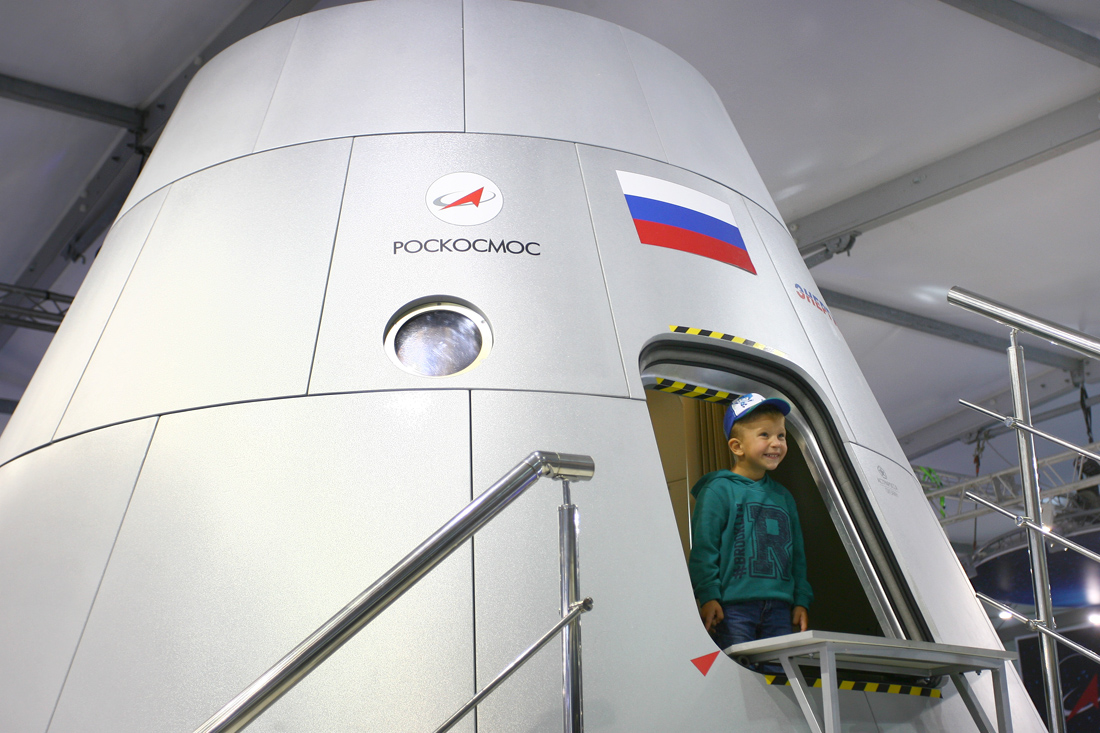
Recently, the lunar theme often pops up in the news. We either fly to the moon , we don’t fly , we fly again , then we don’t fly again ... At the same time, in the depths of Roscosmos, technical equipment is being gradually prepared for the future flight. At the MAKS-2015 air show, several developments were shown, without which such a flight would be impossible.
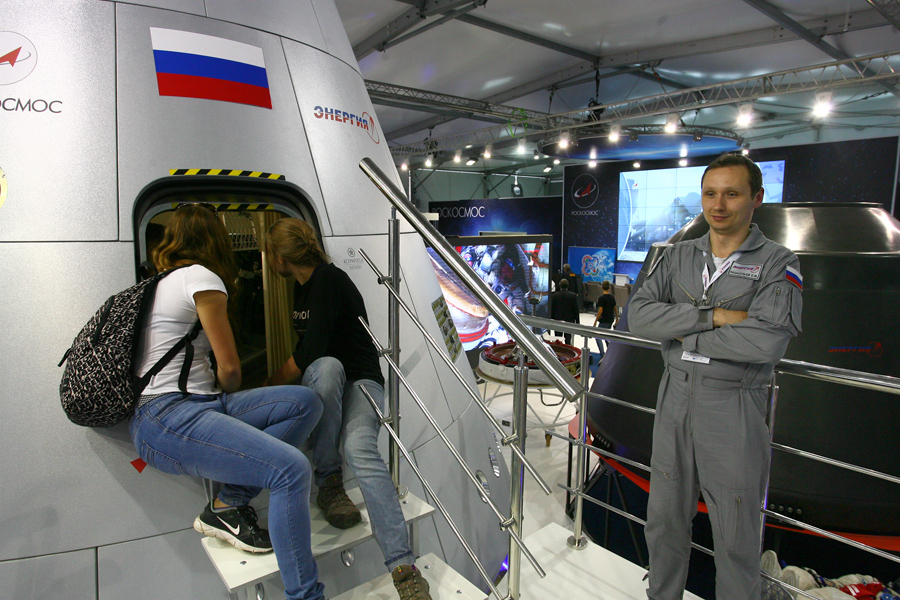
To begin with, the difference between unmanned and manned missions should be indicated. In unmanned mode, a flight to the moon is almost the simplest and cheapest thing you can do in interplanetary space. In the next 10 years it is planned to launch three automatic stations to the Moon: two landing and one orbital. In addition to performing scientific tasks, these devices should give experience in implementing lunar missions to a new generation of engineers. The previous landing on the moon was made in 1976, when a significant part of modern space specialists was not yet born. Therefore, they need to gain experience in deep space and on the surface of the moon.
')
The first flight, it seems, is promised for 2019, and, it seems, it will be the Luna-25 landing gear (Luna-Glob). "It seems to be" because the Federal Space Program 2015-2025 has not yet been approved, and it is not known what changes will be made there, and what will happen in the end.
In any case, at the air show MAKS-2015, the developer of "Luna-25" NPO them. S.A. Lavochkin, put up a full-size mock-up of the lunar vehicle and the Fregat upper stage .
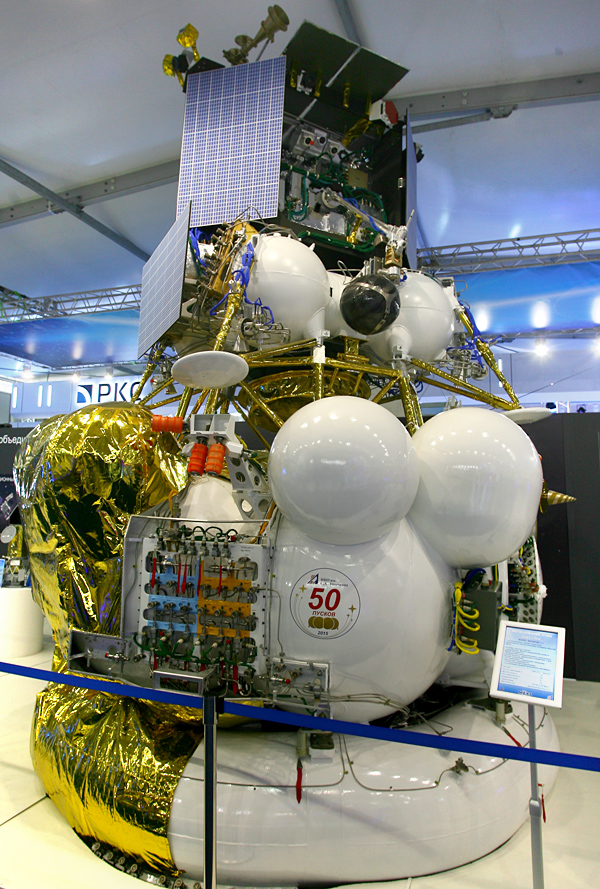
Perhaps the stand of the FOCL, from space, was the most spectacular at the air show. Frankly speaking, I did not expect such a degree of readiness from Luna-25. The composition of scientific equipment and its placement have already been determined.
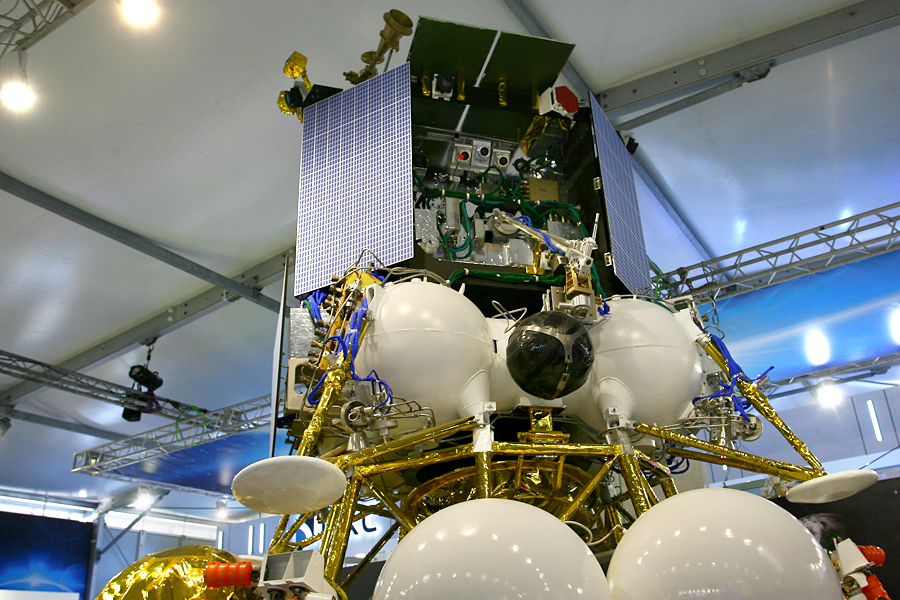
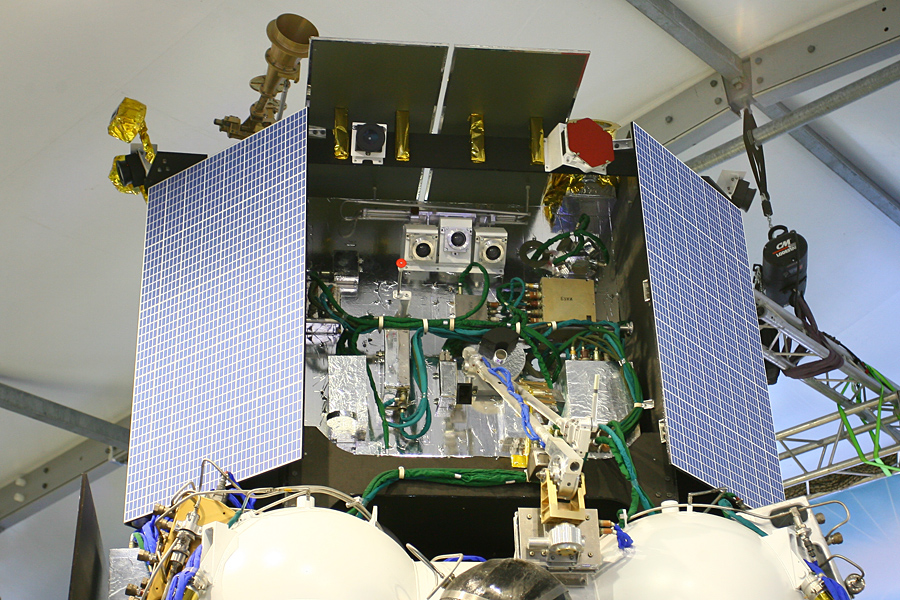
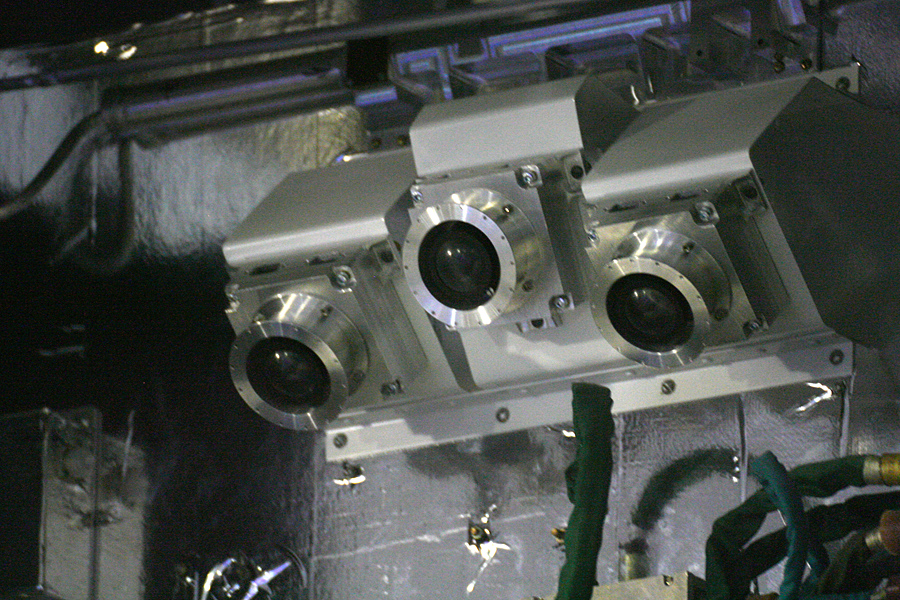
They even made a lug, although I thought that they would do without a manipulator, but the mockup on display was equipped with a bucket.

It’s a pity they didn’t make a camera on the mast so that you can create a spherical panorama , like the one that turned out in the Chinese Chang'e 3.

It remains to hope that the unmanned lunar program for the next decade will remain unchanged, and at least three planned vehicles will make their flight.
But the manned lunar program has no luck. As in the days of the Queen, she remains an extremely expensive enterprise, which, in general, it is not clear why you need it.
The first under the knife went, and not born, super-heavy rocket. Talked about her godok, yes forgotten. Then they honestly admitted that there was no money for it. It would seem that without a super-heavy rocket, the Moon could not be reached, but a multi-trigger scheme came to the rescue.
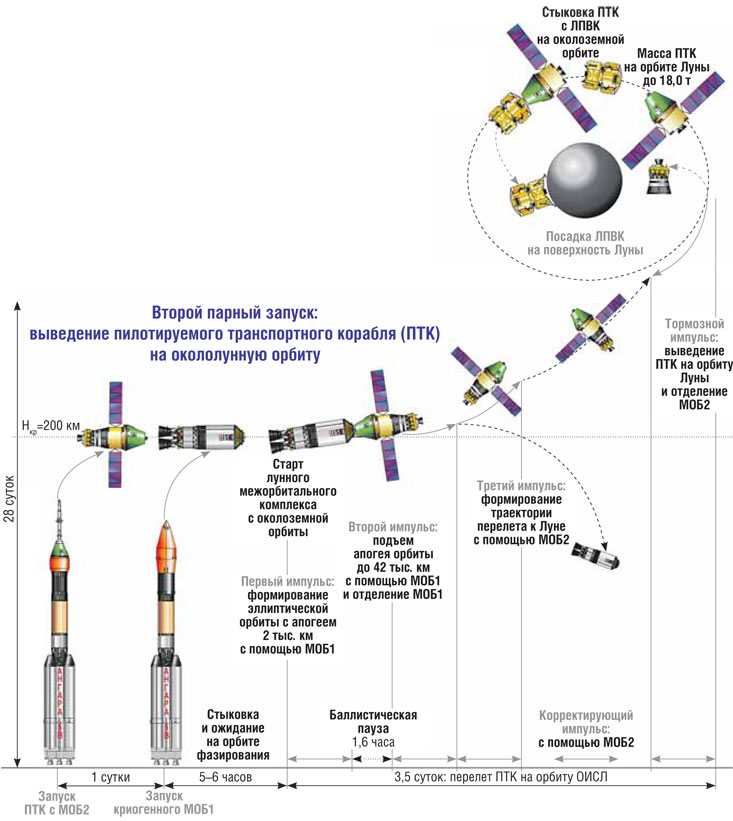
Instead of launching one missile with a loading capacity of one hundred tons, they suggested launching four missiles of thirty tons. Multi-trigger scheme has long been proposed by science fiction writers and designers. It would seem that it is simpler: launch a rocket after rocket and build a large ship a little bit, like the ISS built, for example. But the seeming simplicity hides a bag of pitfalls: all launches will need to be carried out in strict sequence, no delays due to snow, snowstorm or debris in the fuel line are allowed, otherwise the launch windows will crawl. A low near-earth orbit is characterized by the retarding effect of the atmosphere, so the orbit will constantly degrade, and in an unpredictable way, and corrections will have to be made in all launch programs ... There is still a problem that was not known in the 70s - space debris. The ISS regularly, once every 3-4 months, shies away from large pieces, and now the ships have to do this during the two-day flight.
And if at least one rocket something goes wrong? Everything, bury the whole program?
Therefore, Roskosmos was the first who undertook to implement a distant space program under a multi-launch scheme. And this decision comes from poverty - with the current budgets (more precisely the budgets of spring 2015), the Russian cosmonauts will not be able to get to the Moon otherwise. And 2 rockets is only a fly-by. Landing on the moon will require four rockets.
For the sake of justice, it is worth noting that now Russian specialists have accumulated a wealth of experience in carrying out docking in orbit, in automatic and manual modes. The Angara rocket proved to be an unpretentious device that doesn’t care about the weather. So some negative factors can be discarded.
"Moon rocket" should be created on the basis of "Angara-A5", by adding oxygen-hydrogen booster block KVTK.
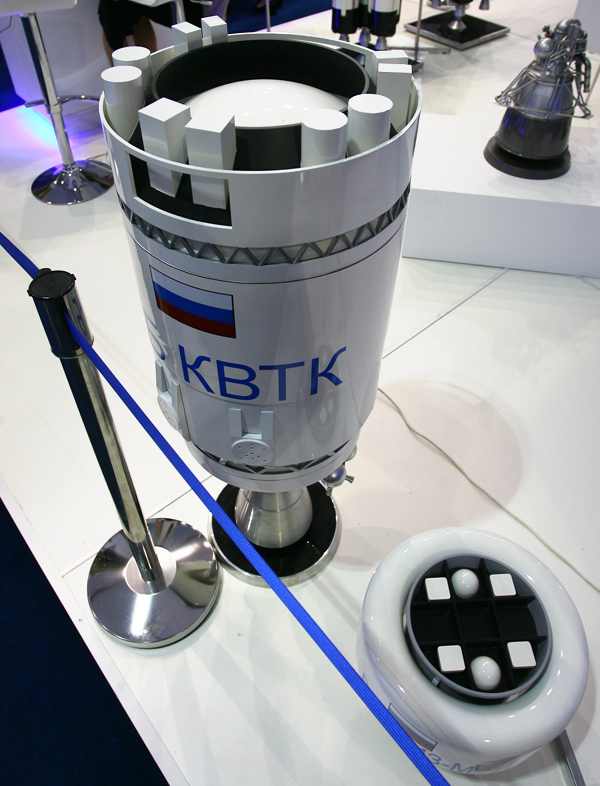
Let me remind you, the number in the name of the "Angara" is the number of modular first-stage accelerators. It was previously assumed that the Angara-A7 would be the most powerful option, but it was abandoned because she demanded a separate starting table. It was decided to do without the "seven" by adding one hydrogen step to the "five". This stage will be KVTK. Together with him the rocket will be called "Angara-A5v", i.e. "hydrogen".
UPD: For "A5v" you need not only KVTK, but also a separate third hydrogen step to the completion of which it is not yet known how much.
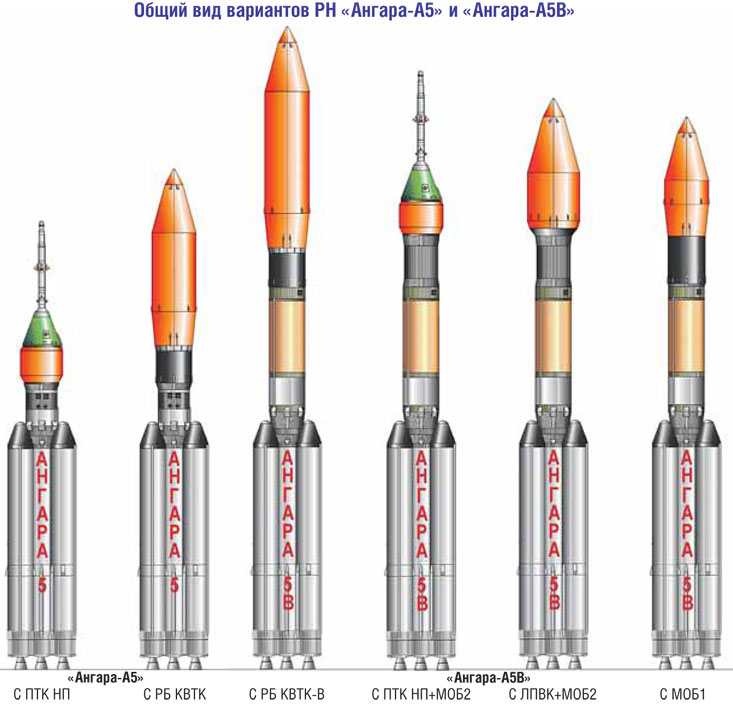
Unfortunately, at the stand of the GNSPC. Khrunichev showed a model of a hydrogen rocket only on the “business day” of the forum, and ordinary visitors like me got only a simple “five” in cargo and manned performance.
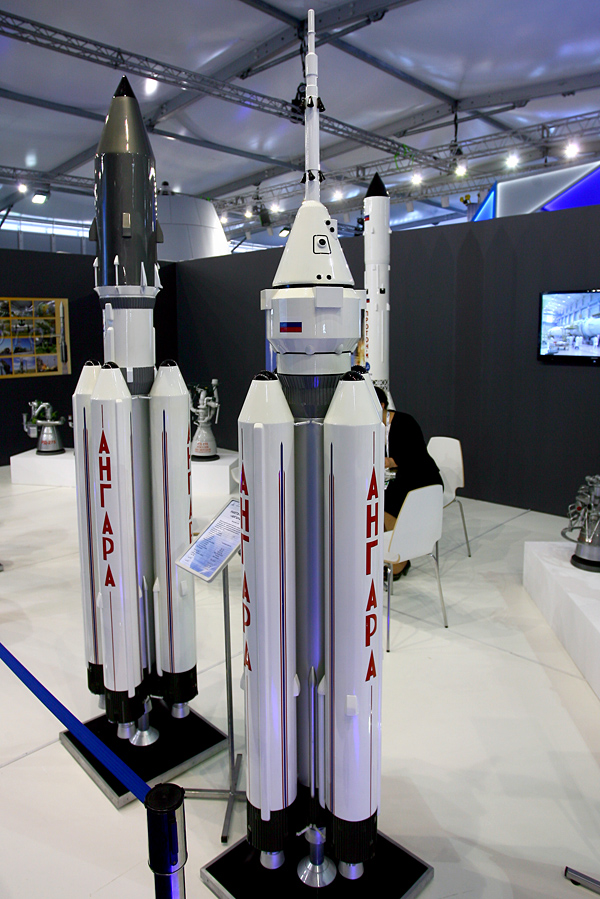
“Hydrogen” is almost one and a half times higher, apparently the organizers decided that crowds of fans of the lunar expansion would demolish the less stable layout, and put it away.
While the KVTC is in development, according to the April 2015 plans, it should be ready by 2020, but cuts in funding for the lunar program may delay this date.
But RSC Energia - the developer of the manned spacecraft PTK NP (Manned transport ship of the new generation) - pleased. At the stand of the corporation one could see important elements of the future lunar mission.
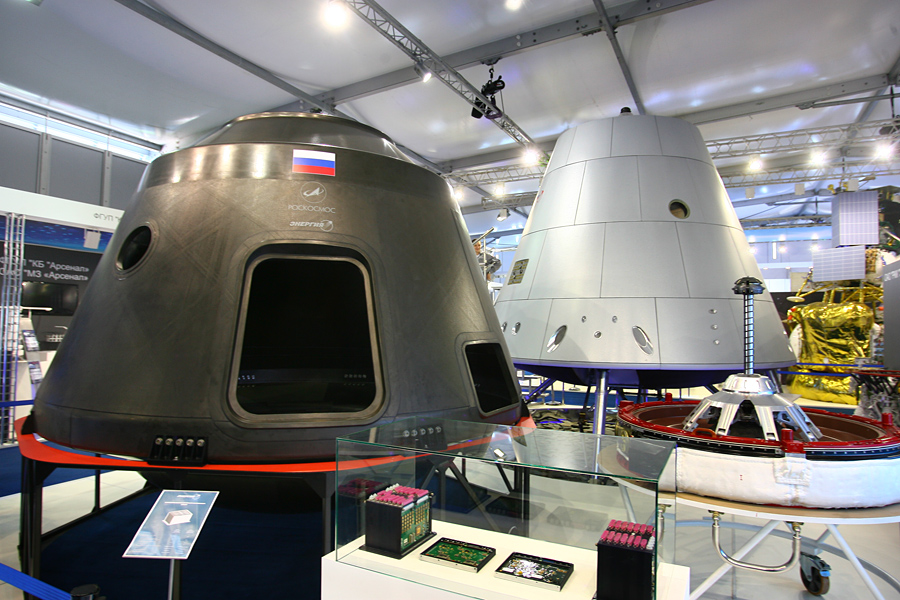
A large model of "pepelats" on the legs showed two years ago. Despite this, all day space fans crowded the entrance ladder, hoping to peek through the hatchway. Only the most fanatical were allowed inside - they were distinguished by their cap and height of no more than a meter.
At the end of the day, with the kind consent of the Energia employees, I managed to stick my hand with the camera into the salon and make a panorama.
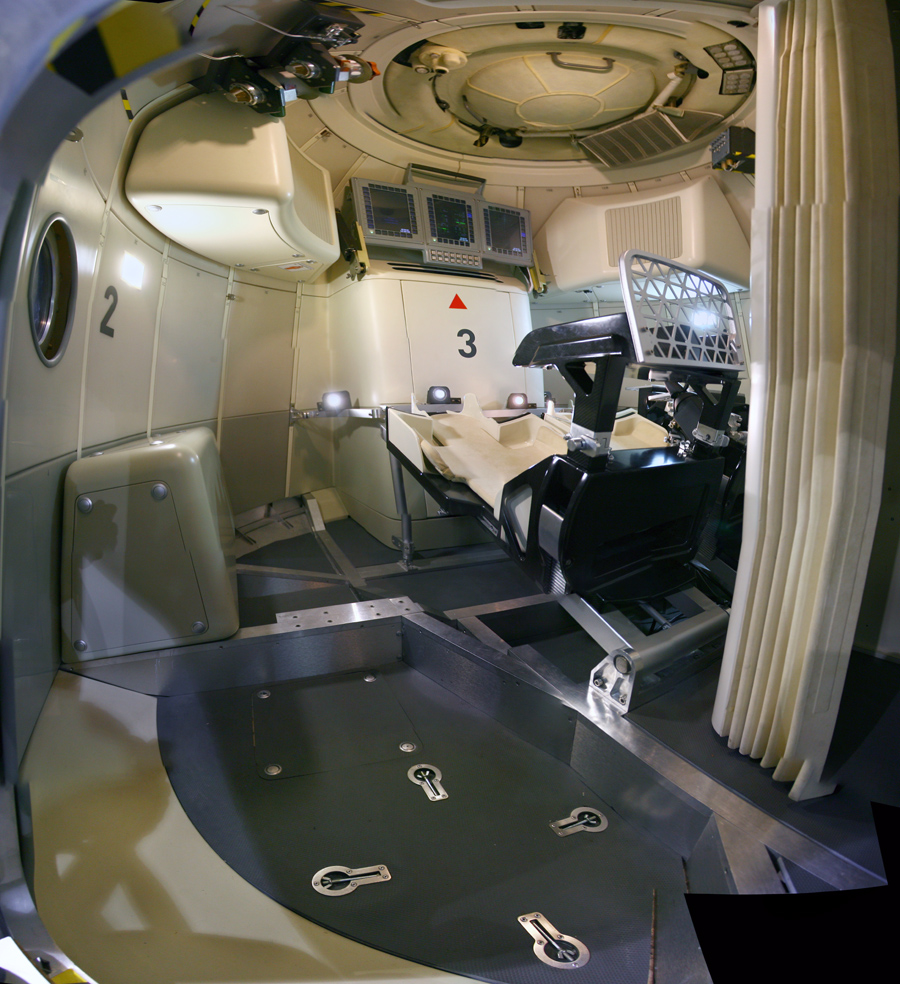
The appearance of the cabin inside is exactly what is supposed to equip a real ship. Of course, in the flight configuration all the free space will be occupied by the payload and additional equipment.
Another line lined up at the real Soyuz-TMA 13 spacecraft returned from space on April 8, 2009. More precisely at his descent capsule. Through the window it was possible to look into the ship, and see the untouched interior, which remained after landing.

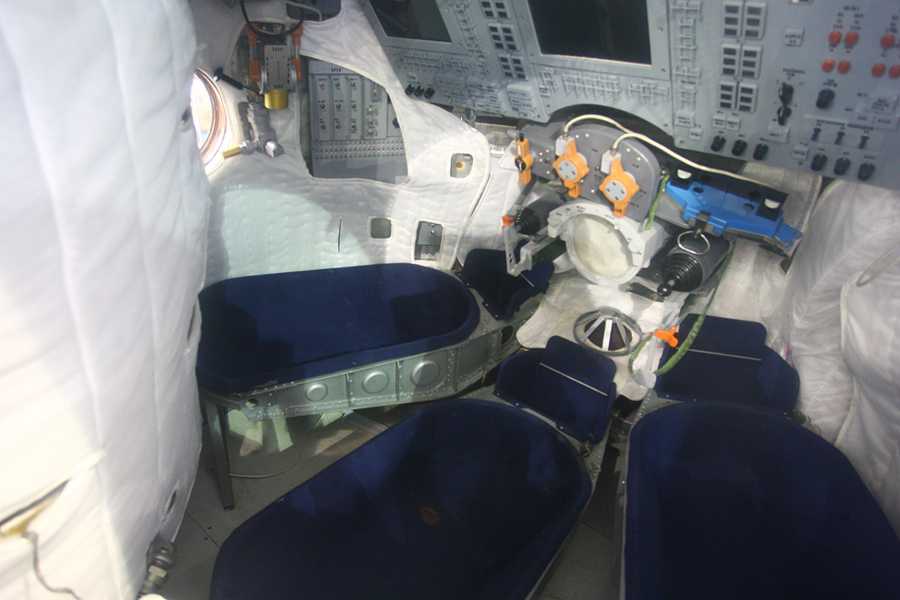
Although, to see the most interesting, it was necessary to look the other way.
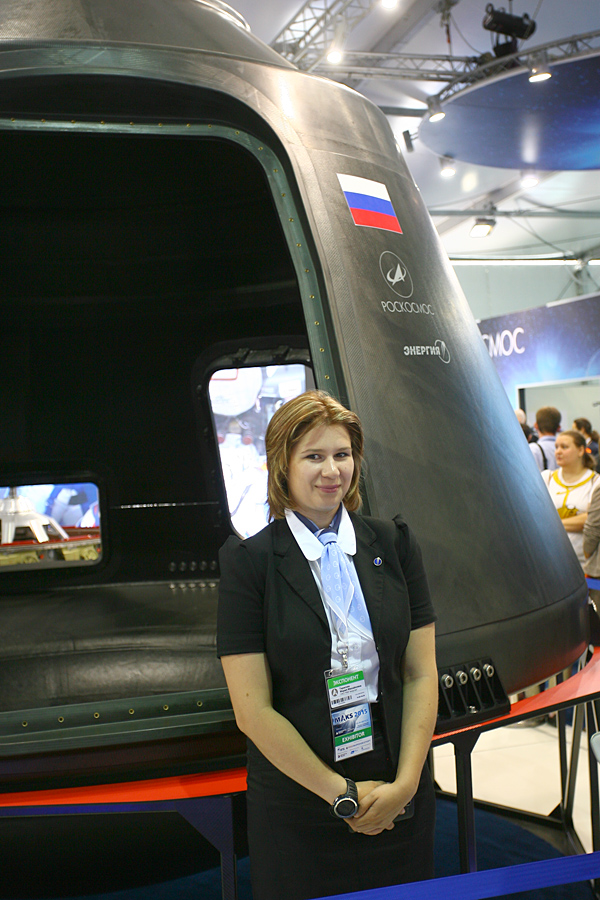
Very few people paid attention to the big black “can”, which occupied a large share of the Energia stand, whereas this was, perhaps, the main “dark horse” of the entire 2015 air show.
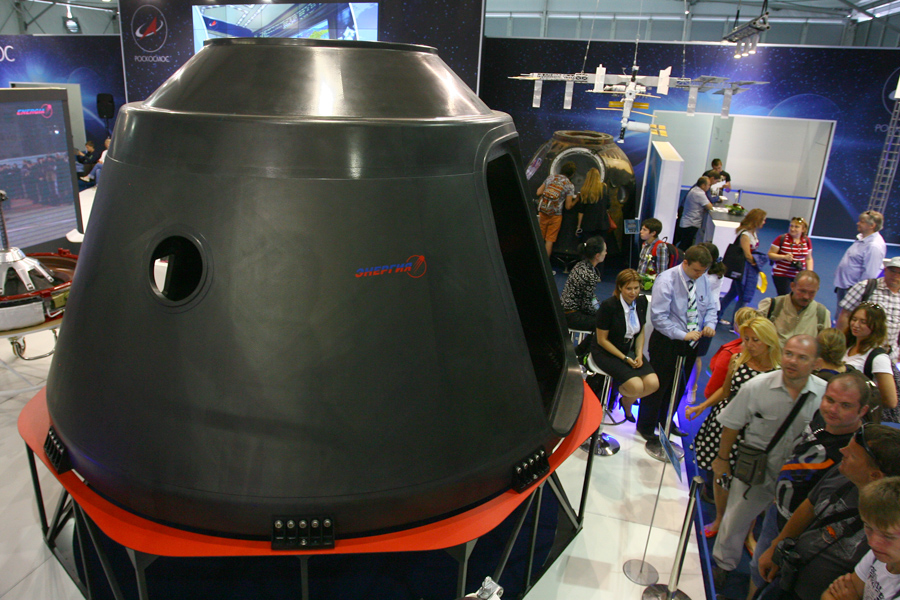
These strange Russians, who often turned everything upside down, again acted contrary to the world's cosmic experience, and made a carbon-fiber spaceship!
Seriously, Energia abandoned the metal in the creation of a rigid rigid body of a spacecraft, and intends to make the carbon frame not only for ships, but also for modules of future space stations. About this product you can, without a bit of irony, say "innovation", and "has no world analogues." There are 5 state and one private spacecraft being created in the world now, and only the Russian one - carbon fiber.
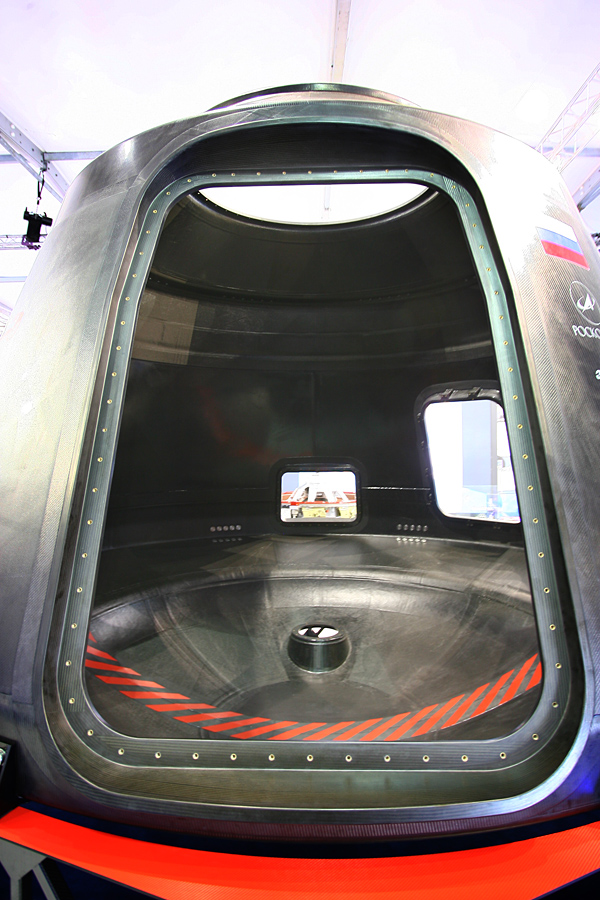
The reason for this decision - the desire to ease the load. This ship can lift and carry four people! Well, okay, not a ship, but only this capsule. Then, life support systems, thermal and radiation protection, engines and fuel, control systems, and four crew seats for the crew are hung on it, and the ship will again become very heavy.
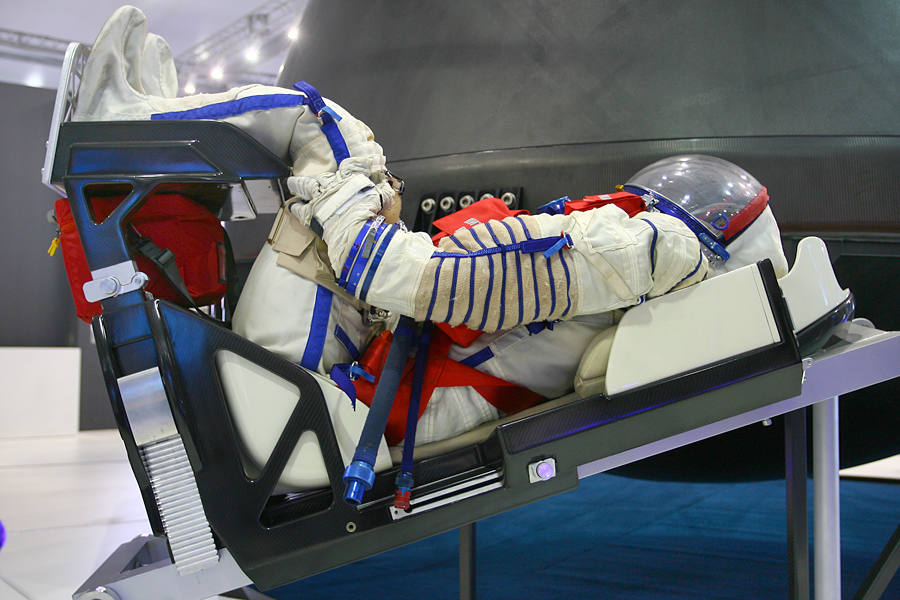
And what would be the scene:
- Hooray, sat down!
- Well! Now we unload, have a snack, and have suffered, have carried to Baikonur ...
Yes, the ship will be reusable. At least the habitable capsule should fly off at least ten times. Now announced a competition to choose the name of the ship .
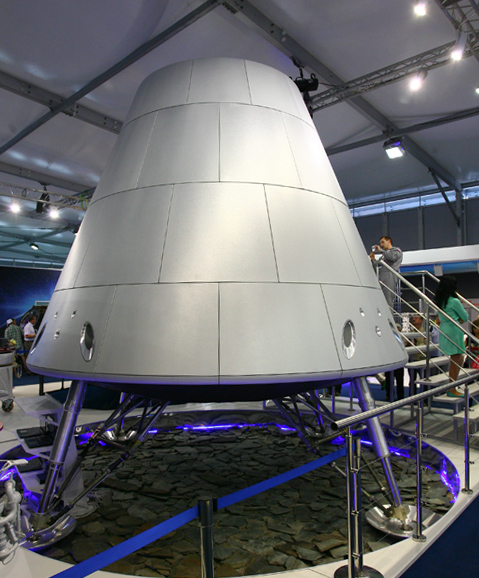
The good news ends there, and the harsh truth of life begins. We must pay tribute to the employees of Roskosmos, they did not hide the fact that the exposed carbon-fiber sample was made to order in Germany. In Russia, there was no production of carbon fiber of such high quality.

The layout on display is fully consistent with the flight pattern, but will not fly into space. He will have to pass numerous tests on the ground. In Germany, must produce three more buildings for ground tests. At the same time, "Energy" is preparing to purchase a production line from the same manufacturer. After that, the Russians will produce four more hulls, and will also test them ... And only after that a flight capsule will be created, which will become the basis for the future promising ship of the new generation.
Considering the speed with which Roscosmos traditionally implements and introduces advanced developments, it can be said that if NPK NP really does fly at least in near-earth flight in 2021, it will be a miracle. And not in the sense of "engineering miracle" (which is certainly the case), but in the sense of "Bilbo, where did you get this ring from?"
Although, they promise to launch the ship even earlier - in 2019. Maybe Harry Potter’s wand was pressed? ..
To reach the moon, we need another miracle - to create a landing lunar module, which is not yet there, and it looks like there will not be at least 10 more years. Therefore, I sincerely hope that at least one of the "masters with a cap" who looked into the ship at the last MAKS will sometime leave its mark on the lunar regolith.
Source: https://habr.com/ru/post/368169/
All Articles